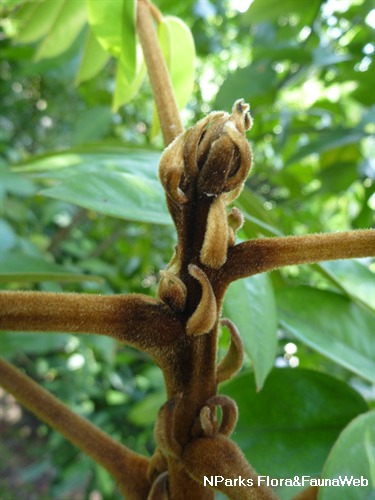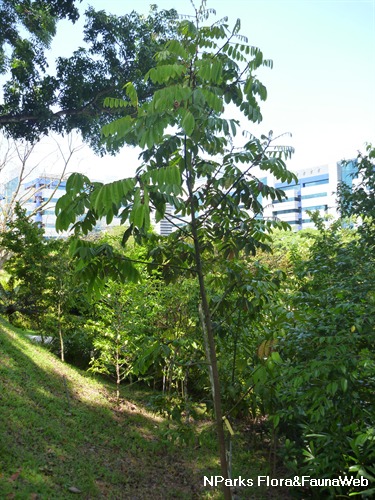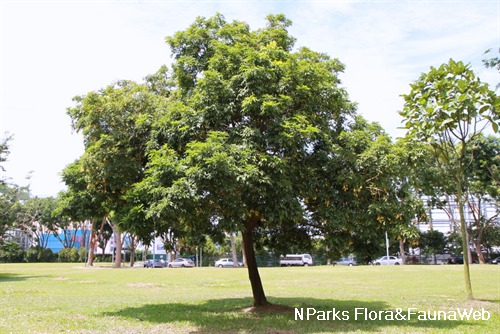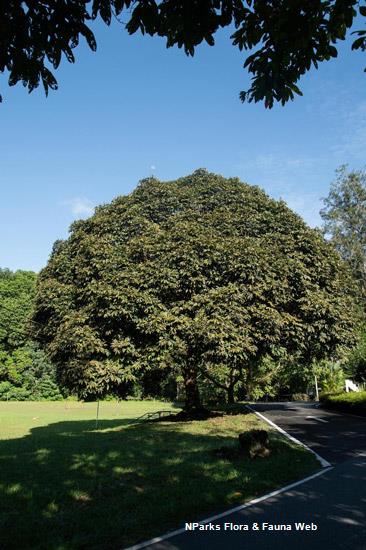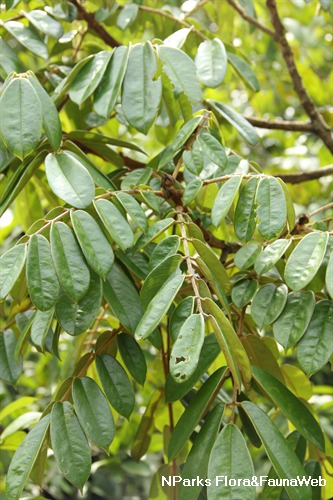
Back
Ormosia sumatrana (Miq.) Prain
| Family Name: | Fabaceae (Leguminosae) |
| Synonyms: | Ormosia microsperma, Macrotropis sumatrana |
| Common Name: | Saga Hutan, Kedondong Hutan, Sepit-sepit |
Name
Classifications and Characteristics
| Plant Division | Angiosperms (Flowering Seed Plants) (Dicotyledon) |
|---|---|
| Plant Growth Form | Tree (Medium (16m-30m)) |
| Lifespan (in Singapore) | Perennial |
| Mode of Nutrition | Autotrophic |
| Plant Shape | Irregular |
| Maximum Height | 20 m to 30 m |
Biogeography
| Native Distribution | Sumatra, Peninsular Malaysia, Singapore, Borneo, and Java |
|---|---|
| Native Habitat | Terrestrial (Primary Rainforest, Secondary Rainforest, Coastal Forest) |
| Preferred Climate Zone | Tropical |
| Local Conservation Status | Native to Singapore (Critically Endangered (CR)) |
Description and Ethnobotany
| Growth Form | It is a tree up to 30 m tall. |
|---|---|
| Foliage | Its alternate, stalked, pinnate leaves are 20–25.5 cm long, with 7–15 leaflets. Its leaflets are golden velvety to almost hairless on the underside. |
| Flowers | Its white flowers develop on branched flowering shoots. |
| Fruit | Its 1–3-seeded pods are oblong and greyish-black. Its seeds are red. |
| Habitat | It grows in lowland forests. |
| Associated Fauna | It is the food plant for the caterpillars of the common grass yellow (Eurema hecabe contubernalis). The dry, inedible seeds are thought to be dispersed by deceit when birds mistake them for juicy red fruits. |
| Cultivation | It can be propagated by seed. |
Landscaping Features
| Landscaping | The leaflets are attractive with their golden-coloured undersides. It is a tree suitable for gardens, parks and roadsides. |
|---|---|
| Desirable Plant Features | Ornamental Foliage |
| Landscape Uses | General, Suitable for Roadsides, Parks & Gardens, Coastal |
Fauna, Pollination and Dispersal
| Fauna Pollination Dispersal Associated Fauna | Bird-Attracting (Seeds), Butterfly Host Plant (Leaves) |
|---|---|
| Pollination Method(s) | Biotic (Fauna) |
| Seed or Spore Dispersal | Biotic (Fauna) |
Plant Care and Propagation
| Light Preference | Full Sun |
|---|---|
| Water Preference | Moderate Water |
| Plant Growth Rate | Moderate |
| Rootzone Tolerance | Moist Soils, Well-Drained Soils, Fertile Loamy Soils |
| Propagation Method | Seed |
Foliar
| Foliage Retention | Evergreen |
|---|---|
| Mature Foliage Colour(s) | Green |
| Mature Foliage Texture(s) | Velvety / Furry / Tomentose |
| Prominent Young Flush Colour(s) | Brown, Yellow / Golden |
| Young Flush Texture(s) | Velvety / Furry / Tomentose |
| Foliar Type | Compound |
| Foliar Arrangement Along Stem | Alternate |
| Foliar Attachment to Stem | Petiolate |
| Foliar Shape(s) | Non-Palm Foliage (Oval) |
| Foliar Venation | Pinnate / Net |
| Foliar Margin | Entire |
Floral (Angiosperm)
| Flower & Plant Sexuality | Bisexual Flowers |
| Flower Colour(s) | White |
|---|---|
| Flower Grouping | Cluster / Inflorescence |
| Flower Location | Axillary |
Fruit, Seed and Spore
| Mature Fruit Colour(s) | Brown |
|---|---|
| Fruit Classification | Simple Fruit |
| Fruit Type | Dehiscent Dry Fruit , Legume / Pod |
Image Repository
Others
| Master ID | 29088 |
|---|---|
| Species ID | 3401 |
| Flora Disclaimer | The information in this website has been compiled from reliable sources, such as reference works on medicinal plants. It is not a substitute for medical advice or treatment and NParks does not purport to provide any medical advice. Readers should always consult his/her physician before using or consuming a plant for medicinal purposes. |


